Haibo Tong
PandaGuard: Systematic Evaluation of LLM Safety against Jailbreaking Attacks
May 22, 2025Abstract:Large language models (LLMs) have achieved remarkable capabilities but remain vulnerable to adversarial prompts known as jailbreaks, which can bypass safety alignment and elicit harmful outputs. Despite growing efforts in LLM safety research, existing evaluations are often fragmented, focused on isolated attack or defense techniques, and lack systematic, reproducible analysis. In this work, we introduce PandaGuard, a unified and modular framework that models LLM jailbreak safety as a multi-agent system comprising attackers, defenders, and judges. Our framework implements 19 attack methods and 12 defense mechanisms, along with multiple judgment strategies, all within a flexible plugin architecture supporting diverse LLM interfaces, multiple interaction modes, and configuration-driven experimentation that enhances reproducibility and practical deployment. Built on this framework, we develop PandaBench, a comprehensive benchmark that evaluates the interactions between these attack/defense methods across 49 LLMs and various judgment approaches, requiring over 3 billion tokens to execute. Our extensive evaluation reveals key insights into model vulnerabilities, defense cost-performance trade-offs, and judge consistency. We find that no single defense is optimal across all dimensions and that judge disagreement introduces nontrivial variance in safety assessments. We release the code, configurations, and evaluation results to support transparent and reproducible research in LLM safety.
Redefining Superalignment: From Weak-to-Strong Alignment to Human-AI Co-Alignment to Sustainable Symbiotic Society
Apr 24, 2025Abstract:Artificial Intelligence (AI) systems are becoming increasingly powerful and autonomous, and may progress to surpass human intelligence levels, namely Artificial Superintelligence (ASI). During the progression from AI to ASI, it may exceed human control, violate human values, and even lead to irreversible catastrophic consequences in extreme cases. This gives rise to a pressing issue that needs to be addressed: superalignment, ensuring that AI systems much smarter than humans, remain aligned with human (compatible) intentions and values. Existing scalable oversight and weak-to-strong generalization methods may prove substantially infeasible and inadequate when facing ASI. We must explore safer and more pluralistic frameworks and approaches for superalignment. In this paper, we redefine superalignment as the human-AI co-alignment towards a sustainable symbiotic society, and highlight a framework that integrates external oversight and intrinsic proactive alignment. External oversight superalignment should be grounded in human-centered ultimate decision, supplemented by interpretable automated evaluation and correction, to achieve continuous alignment with humanity's evolving values. Intrinsic proactive superalignment is rooted in a profound understanding of the self, others, and society, integrating self-awareness, self-reflection, and empathy to spontaneously infer human intentions, distinguishing good from evil and proactively considering human well-being, ultimately attaining human-AI co-alignment through iterative interaction. The integration of externally-driven oversight with intrinsically-driven proactive alignment empowers sustainable symbiotic societies through human-AI co-alignment, paving the way for achieving safe and beneficial AGI and ASI for good, for human, and for a symbiotic ecology.
MJ-VIDEO: Fine-Grained Benchmarking and Rewarding Video Preferences in Video Generation
Feb 03, 2025


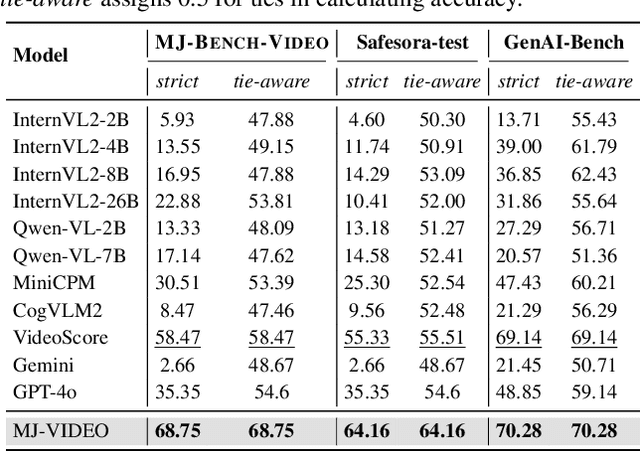
Abstract:Recent advancements in video generation have significantly improved the ability to synthesize videos from text instructions. However, existing models still struggle with key challenges such as instruction misalignment, content hallucination, safety concerns, and bias. Addressing these limitations, we introduce MJ-BENCH-VIDEO, a large-scale video preference benchmark designed to evaluate video generation across five critical aspects: Alignment, Safety, Fineness, Coherence & Consistency, and Bias & Fairness. This benchmark incorporates 28 fine-grained criteria to provide a comprehensive evaluation of video preference. Building upon this dataset, we propose MJ-VIDEO, a Mixture-of-Experts (MoE)-based video reward model designed to deliver fine-grained reward. MJ-VIDEO can dynamically select relevant experts to accurately judge the preference based on the input text-video pair. This architecture enables more precise and adaptable preference judgments. Through extensive benchmarking on MJ-BENCH-VIDEO, we analyze the limitations of existing video reward models and demonstrate the superior performance of MJ-VIDEO in video preference assessment, achieving 17.58% and 15.87% improvements in overall and fine-grained preference judgments, respectively. Additionally, introducing MJ-VIDEO for preference tuning in video generation enhances the alignment performance.
Autonomous Alignment with Human Value on Altruism through Considerate Self-imagination and Theory of Mind
Jan 07, 2025Abstract:With the widespread application of Artificial Intelligence (AI) in human society, enabling AI to autonomously align with human values has become a pressing issue to ensure its sustainable development and benefit to humanity. One of the most important aspects of aligning with human values is the necessity for agents to autonomously make altruistic, safe, and ethical decisions, considering and caring for human well-being. Current AI extremely pursues absolute superiority in certain tasks, remaining indifferent to the surrounding environment and other agents, which has led to numerous safety risks. Altruistic behavior in human society originates from humans' capacity for empathizing others, known as Theory of Mind (ToM), combined with predictive imaginative interactions before taking action to produce thoughtful and altruistic behaviors. Inspired by this, we are committed to endow agents with considerate self-imagination and ToM capabilities, driving them through implicit intrinsic motivations to autonomously align with human altruistic values. By integrating ToM within the imaginative space, agents keep an eye on the well-being of other agents in real time, proactively anticipate potential risks to themselves and others, and make thoughtful altruistic decisions that balance negative effects on the environment. The ancient Chinese story of Sima Guang Smashes the Vat illustrates the moral behavior of the young Sima Guang smashed a vat to save a child who had accidentally fallen into it, which is an excellent reference scenario for this paper. We design an experimental scenario similar to Sima Guang Smashes the Vat and its variants with different complexities, which reflects the trade-offs and comprehensive considerations between self-goals, altruistic rescue, and avoiding negative side effects.
Evolving Efficient Genetic Encoding for Deep Spiking Neural Networks
Nov 11, 2024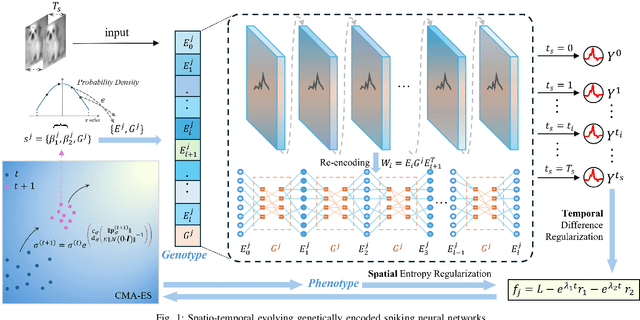
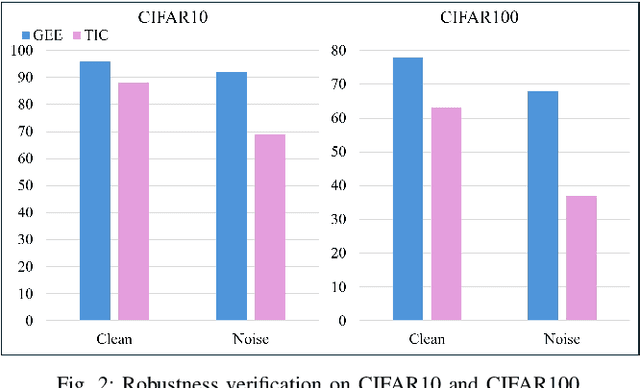
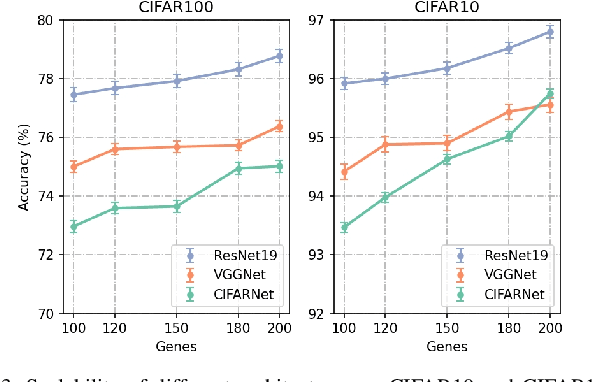
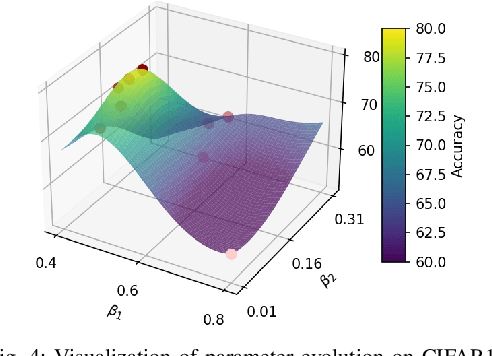
Abstract:By exploiting discrete signal processing and simulating brain neuron communication, Spiking Neural Networks (SNNs) offer a low-energy alternative to Artificial Neural Networks (ANNs). However, existing SNN models, still face high computational costs due to the numerous time steps as well as network depth and scale. The tens of billions of neurons and trillions of synapses in the human brain are developed from only 20,000 genes, which inspires us to design an efficient genetic encoding strategy that dynamic evolves to regulate large-scale deep SNNs at low cost. Therefore, we first propose a genetically scaled SNN encoding scheme that incorporates globally shared genetic interactions to indirectly optimize neuronal encoding instead of weight, which obviously brings about reductions in parameters and energy consumption. Then, a spatio-temporal evolutionary framework is designed to optimize the inherently initial wiring rules. Two dynamic regularization operators in the fitness function evolve the neuronal encoding to a suitable distribution and enhance information quality of the genetic interaction respectively, substantially accelerating evolutionary speed and improving efficiency. Experiments show that our approach compresses parameters by approximately 50\% to 80\%, while outperforming models on the same architectures by 0.21\% to 4.38\% on CIFAR-10, CIFAR-100 and ImageNet. In summary, the consistent trends of the proposed genetically encoded spatio-temporal evolution across different datasets and architectures highlight its significant enhancements in terms of efficiency, broad scalability and robustness, demonstrating the advantages of the brain-inspired evolutionary genetic coding for SNN optimization.
Building Altruistic and Moral AI Agent with Brain-inspired Affective Empathy Mechanisms
Oct 29, 2024



Abstract:As AI closely interacts with human society, it is crucial to ensure that its decision-making is safe, altruistic, and aligned with human ethical and moral values. However, existing research on embedding ethical and moral considerations into AI remains insufficient, and previous external constraints based on principles and rules are inadequate to provide AI with long-term stability and generalization capabilities. In contrast, the intrinsic altruistic motivation based on empathy is more willing, spontaneous, and robust. Therefore, this paper is dedicated to autonomously driving intelligent agents to acquire morally behaviors through human-like affective empathy mechanisms. We draw inspiration from the neural mechanism of human brain's moral intuitive decision-making, and simulate the mirror neuron system to construct a brain-inspired affective empathy-driven altruistic decision-making model. Here, empathy directly impacts dopamine release to form intrinsic altruistic motivation. Based on the principle of moral utilitarianism, we design the moral reward function that integrates intrinsic empathy and extrinsic self-task goals. A comprehensive experimental scenario incorporating empathetic processes, personal objectives, and altruistic goals is developed. The proposed model enables the agent to make consistent moral decisions (prioritizing altruism) by balancing self-interest with the well-being of others. We further introduce inhibitory neurons to regulate different levels of empathy and verify the positive correlation between empathy levels and altruistic preferences, yielding conclusions consistent with findings from psychological behavioral experiments. This work provides a feasible solution for the development of ethical AI by leveraging the intrinsic human-like empathy mechanisms, and contributes to the harmonious coexistence between humans and AI.
Correct after Answer: Enhancing Multi-Span Question Answering with Post-Processing Method
Oct 22, 2024



Abstract:Multi-Span Question Answering (MSQA) requires models to extract one or multiple answer spans from a given context to answer a question. Prior work mainly focuses on designing specific methods or applying heuristic strategies to encourage models to predict more correct predictions. However, these models are trained on gold answers and fail to consider the incorrect predictions. Through a statistical analysis, we observe that models with stronger abilities do not predict less incorrect predictions compared with other models. In this work, we propose Answering-Classifying-Correcting (ACC) framework, which employs a post-processing strategy to handle incorrect predictions. Specifically, the ACC framework first introduces a classifier to classify the predictions into three types and exclude "wrong predictions", then introduces a corrector to modify "partially correct predictions". Experiments on several MSQA datasets show that ACC framework significantly improves the Exact Match (EM) scores, and further analysis demostrates that ACC framework efficiently reduces the number of incorrect predictions, improving the quality of predictions.
A Lightweight Multi Aspect Controlled Text Generation Solution For Large Language Models
Oct 18, 2024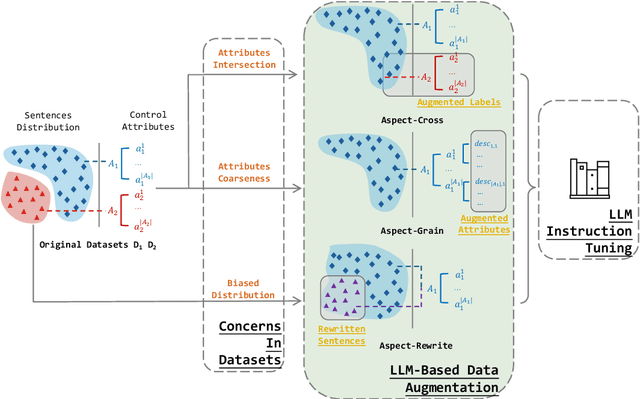

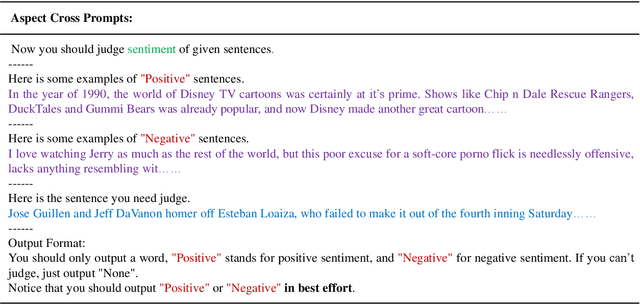

Abstract:Large language models (LLMs) show remarkable abilities with instruction tuning. However, they fail to achieve ideal tasks when lacking high-quality instruction tuning data on target tasks. Multi-Aspect Controllable Text Generation (MCTG) is a representative task for this dilemma, where aspect datasets are usually biased and correlated. Existing work exploits additional model structures and strategies for solutions, limiting adaptability to LLMs. To activate MCTG ability of LLMs, we propose a lightweight MCTG pipeline based on data augmentation. We analyze bias and correlations in traditional datasets, and address these concerns with augmented control attributes and sentences. Augmented datasets are feasible for instruction tuning. In our experiments, LLMs perform better in MCTG after data augmentation, with a 20% accuracy rise and less aspect correlations.
Probing Causality Manipulation of Large Language Models
Aug 26, 2024



Abstract:Large language models (LLMs) have shown various ability on natural language processing, including problems about causality. It is not intuitive for LLMs to command causality, since pretrained models usually work on statistical associations, and do not focus on causes and effects in sentences. So that probing internal manipulation of causality is necessary for LLMs. This paper proposes a novel approach to probe causality manipulation hierarchically, by providing different shortcuts to models and observe behaviors. We exploit retrieval augmented generation (RAG) and in-context learning (ICL) for models on a designed causality classification task. We conduct experiments on mainstream LLMs, including GPT-4 and some smaller and domain-specific models. Our results suggest that LLMs can detect entities related to causality and recognize direct causal relationships. However, LLMs lack specialized cognition for causality, merely treating them as part of the global semantic of the sentence.
 Add to Chrome
Add to Chrome Add to Firefox
Add to Firefox Add to Edge
Add to Edge